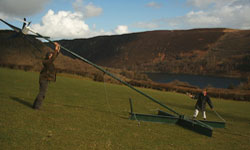
A spectacular 90% annual reduction in diesel usage for power generation purposes has been recorded by the specialist organic mutton producers, Elan Valley Mutton Co., following the installation of a FuturEnergy one-kilowatt wind turbine and a solar panel array at its remote farm in the picturesque Elan Valley, mid-Wales.
Positioned some 1100-feet above sea level, Henfron Farm and its 1700-acres of mainly unfenced moorland, is too remote to be connected to the national grid, forcing farmer Tony Davies, his wife Angela and their four children to rely on a diesel generator for all their electricity, with its associated noise, pollution and ever-increasing costs.
A strong commitment to the environment is evidenced both in the way the farm operates within strict organic guidelines and in the low-energy lifestyle adopted by the family. Although making use of all the domestic appliances and gadgets so essential to modern living, particularly with four young children, the Davies family consumes just six-kilowatt hours of electricity per day compared to the 10-20 kilowatt hours required by most households.
The latest phase in the farm's drive to minimise its environmental impact, the installation of the FuturEnergy wind turbine, allied to the 3-metre x 4-metre fixed solar array installed some six-months earlier, generally provides more than enough power to cover the family's daily needs.
With all cooking and heating provided by a solid fuel range and log-burning stove, the diesel generator has now been relegated to a standby role, cutting in only when poor weather conditions impact on the efficiency of the turbine and the solar cells to recharge the storage batteries at the heart of the electrical system, or when particularly high power-drain farm machinery is to be used.
Designed to start generating electricity at much lower wind speeds than other comparable turbines for domestic and rural use, the FuturEnergy turbine with a 24-volt one-kilowatt output, was supplied as an off-the-shelf unit for just £695. Utilising his own skills, Tony Davies installed the turbine on a six-metre tower fixed to a robust, yet moveable, cross-shape hollow steel base. The portable nature of the turbine structure enables it to be moved around its field location when hay is to be harvested.
Installed during the summer of 2006, the large fixed solar array is made up of 10 individual BP solar cells with a total area of three-metres x four-metres capable of generating a maximum output of 1.7 Kilowatts at 24-volts, and predicted to generate 1360kwh (kilowatt hours) of electricity annually.
Power from both the wind turbine and solar array is stored ready for use in a 12-cell battery bank - obtained second-hand from a telecommunications station – which, once fully-charged holds sufficient electricity to supply the family's needs for three - four days. A charge controller protects the batteries from overcharging during periods of excessive power generation.
Prior to its supply to the farm house to power low-energy lights, central heating pump and the usual mix of domestic appliances including television, computer and washing machine, the 24-volt DC (direct current) electricity in the batteries passes through a trace inverter which converts it into a conventional 240-volt AC (alternating current) supply.
"With the installation of the new wind turbine we now have the best of both worlds," comments farmer Tony Davies, "making us almost wholly energy self-sufficient throughout the year. The solar panels are more than capable of generating all the electricity we need during the summer months, whilst the wind turbine should supply most of our requirements during the autumn and winter."
So notable are the annual savings on diesel, that it is anticipated that the cost of the wind turbine plus all its ancillaries will be recouped in significantly less than five years. The solar panel array, which benefited from a 50% government grant reducing its cost from £9,000 to £4,500, is expected to pay for itself in just 10-years.
Other energy generating initiatives planned for the next few months include the installation of a 300-watt micro water turbine powered from a nearby brook. Capable of generating another 5kwh daily, the water turbine will not only build on the farm's current 90% energy self-sufficiency but will also provide the extra power required for additional refrigeration as demand for the farm's award-winning organic mutton increases. .
